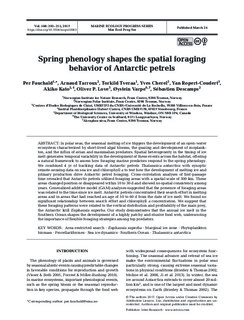Spring phenology shapes the spatial foraging behavior of Antarctic petrels
Fauchald, Per; Tarroux, Arnaud; Tveraa, Torkild; Cherel, Yves; Ropert-Coudert, Yan; Kato, Akiko; Love, Oliver P.; Varpe, Øystein; Descamps, Sébastien
Journal article, Peer reviewed

Åpne
Permanent lenke
http://hdl.handle.net/11250/2443718Utgivelsesdato
2017Metadata
Vis full innførselSamlinger
- Publikasjoner fra CRIStin - NINA [2399]
- Scientific publications [1425]
Sammendrag
In polar seas, the seasonal melting of ice triggers the development of an open-water ecosystem characterized by short-lived algal blooms, the grazing and development of zooplankton, and the influx of avian and mammalian predators. Spatial heterogeneity in the timing of ice melt generates temporal variability in the development of these events across the habitat, offering a natural framework to assess how foraging marine predators respond to the spring phenology. We combined 4 yr of tracking data of Antarctic petrels Thalassoica antarctica with synoptic remote-sensing data on sea ice and chlorophyll a to test how the development of melting ice and primary production drive Antarctic petrel foraging. Cross-correlation analyses of first-passage time revealed that Antarctic petrels utilized foraging areas with a spatial scale of 300 km. These areas changed position or disappeared within 10 to 30 d and showed no spatial consistency among years. Generalized additive model (GAM) analyses suggested that the presence of foraging areas was related to the time since ice melt. Antarctic petrels concentrated their search effort in melting areas and in areas that had reached an age of 50 to 60 d from the date of ice melt. We found no significant relationship between search effort and chlorophyll a concentration. We suggest that these foraging patterns were related to the vertical distribution and profitability of the main prey, the Antarctic krill Euphausia superba. Our study demonstrates that the annual ice melt in the Southern Ocean shapes the development of a highly patchy and elusive food web, underscoring the importance of flexible foraging strategies among top predators. Area-restricted search · Euphausia superba · Marginal ice zone · Phytoplankton biomass · Procellariiformes · Sea ice dynamics · Southern Ocean · Thalassoica antarctica
